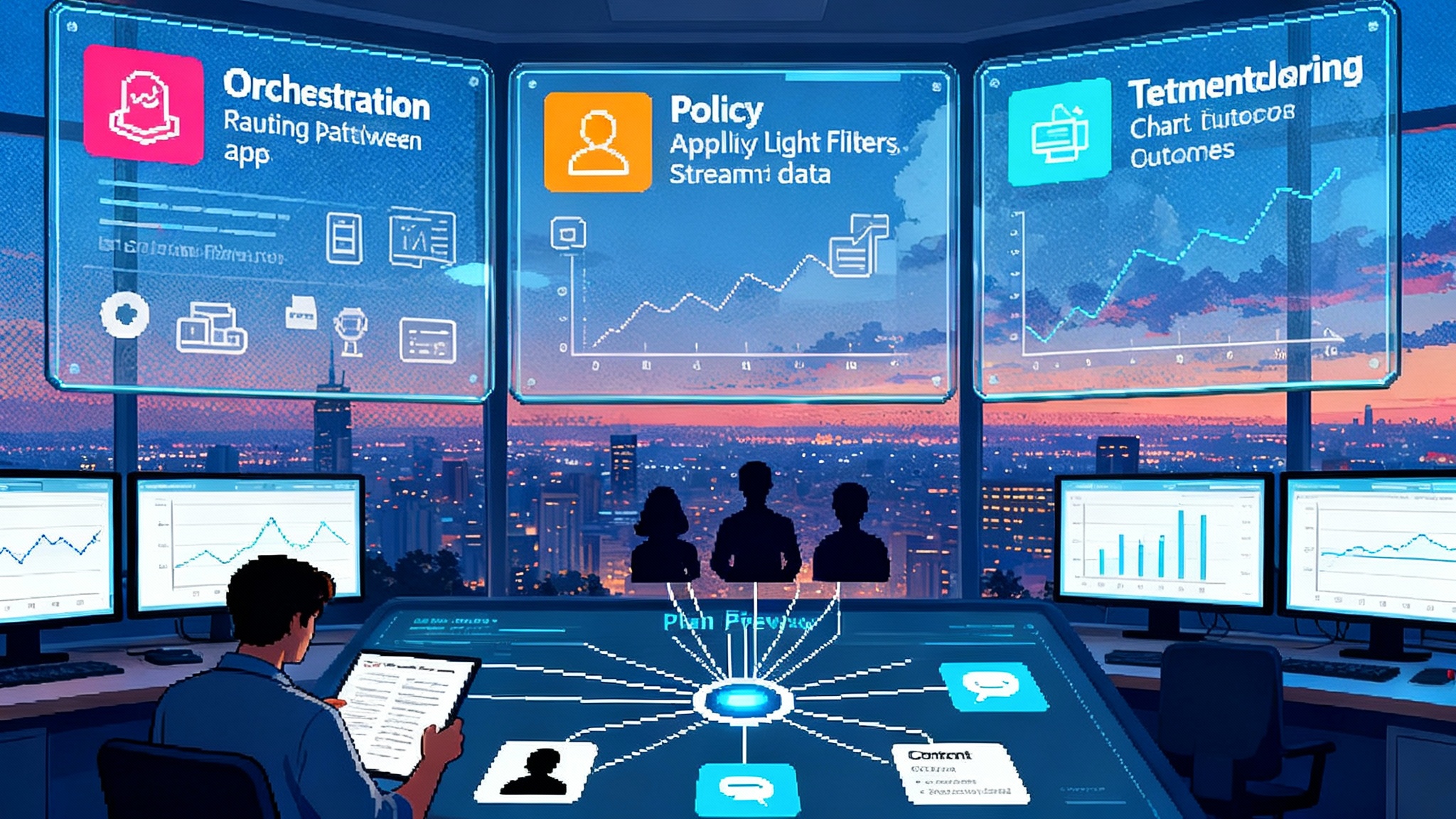TIME launches a brand-grade newsroom agent with Scale AI
TIME just switched on a governed newsroom agent that can summarize, speak, translate, and search a century of reporting. Built with Scale AI, it signals a shift from static pages to callable, brand-safe services.

Breaking: a newsroom agent you can actually use
On November 11, 2025, TIME turned on a persistent, brand-governed newsroom agent for readers. This is not a novelty chatbot or a tucked away widget. It is a production system that understands TIME’s archive, answers questions in context, and performs helpful tasks like summarizing, voicing briefings, and translating stories. TIME’s own coverage lays out the intent and constraints behind the launch in two places worth reading: The story behind the TIME AI Agent and the more technical TIME AI Agent Frequently Asked Questions.
Why this matters now is simple. TIME is positioning itself among the first major American magazines to run a full-stack, consumer-facing agent that is grounded in a trusted archive and governed by brand rules. For media leaders, that makes the launch a reference design for how journalism becomes a living service rather than a static page.
What TIME actually shipped
At a high level, the TIME agent can do four things readers immediately understand:
- Summarize long articles or sets of articles into fast briefs.
- Speak those briefs in a consistent house voice for easy listening.
- Translate answers into other languages while preserving tone and clarity.
- Search across a century of reporting to ground answers in real sources.
The important detail is not any one capability. It is how those capabilities are orchestrated by a reasoning core and surrounded by safety, attribution, and logging. The experience feels like a single assistant because the model decides when to retrieve, when to summarize, and when to speak, all under policy.
The architecture pattern you can copy
Think of the TIME agent as a newsroom brain that does not wing it. It looks up facts first, reasons over what it found, and then responds in text or voice. Under the hood, the pattern has five pillars.
1) First party retrieval as ground truth
Retrieval augmented generation ties the agent to a private index of TIME’s journalism. When a reader asks a question, the system searches TIME’s archive, pulls top passages, and drafts an answer that cites those passages. This reduces hallucinations and puts the brand’s standards back in charge of what counts as verified. In practical terms, RAG is an editorial checklist encoded in software: cite sources, show receipts, and favor your reporting over the open internet.
2) A reasoning core with specialized tools
A large language model serves as planner and writer. Around it sit specialized tools for summarization, translation, voice, and search. The model picks tools as needed, which is why the experience feels unified. The reader sees one assistant, not a tray of buttons.
3) Native voice that sounds like the brand
The system can turn text answers into audio briefings with a familiar tone and pacing. That matters for access, habit formation, and monetization. Many readers expect a morning or evening brief they can listen to on the go. Voice turns the agent into a daily ritual where the brand is literally heard.
4) Safety and governance enforced at runtime
TIME describes input filtering to block harmful prompts, output moderation to preserve tone and style, red teaming to probe failure cases, and business rules that protect attribution and author credit. The notable choice is to enforce these rules at runtime and log them for audit. Safety is treated as a product surface, not a policy document.
5) Observability and receipts by default
Every retrieval result, tool call, and final answer should be traceable back to source material. That traceability gives editors a path to review what the agent did and gives external partners confidence when they call the agent for answers.
Why this blueprint matters for every publisher
The launch is more than a TIME product. It is a template for how media companies adapt to the agent era. Four shifts stand out.
Shift 1: Control the ground truth, then scale it
Search engines and general chatbots remix your journalism with the rest of the internet. First party RAG restores editorial control by making your archive the ground truth. The benefit is accuracy with brand safety and author credit. It also unlocks new revenue options because you can prove that answers are derived from your content. For example, a health explainer about heat stroke can be guaranteed to cite the right paragraphs of your reporting. That provenance is a sellable asset to subscribers and advertisers.
Shift 2: Move from pages to sessions
Analytics have long counted page views. Agents measure sessions. A reader might ask for a five minute audio brief on ceasefire talks, then a comparison of three analyses from last spring, then a Spanish translation to share with a parent. Each step carries value. Sponsorships can follow the brief, upgrades can unlock comparisons, and the translation can drive broader reach. The agent becomes a session host that measures and improves the whole journey, not just a sequence of clicks.
Shift 3: Build new ad inventory around actions
Display ads fit rectangles. Agent experiences sell outcomes in a flow. If a reader asks for a weekly climate brief, a brand can sponsor that recurring brief with a frequency cap and a voice tag at the open. If a reader asks for a city guide drawn from your culture desk, the agent can offer a bookable restaurant through a vetted partner. The placement is native to the user’s intent and measurable without chasing the user across the web.
Shift 4: Defend distribution by being callable
In the agent era, distribution is not only homepages and social feeds. It is also other assistants calling your agent for authoritative answers. A publisher that becomes callable keeps attribution and economics attached to its work even as distribution fragments. TIME’s launch is an early stake in that direction.
How to replicate the pattern without guesswork
You can build a near equivalent system by sequencing the work. The technology exists. The differentiator is editorial and operational discipline.
Corpus readiness
Clean the archive. Deduplicate near identical copies. Chunk long features into coherent passages. Tag by desk, topic, entities, and recency. Flag embargoed material and rights restricted assets. RAG quality is governed by corpus hygiene more than model choice.
Index design
Use hybrid search that marries classic signals like term frequency with semantic vectors. Favor passage level retrieval to keep answers tight and citations precise. Version your index so that corrections and takedowns propagate.
Guardrails, then user experience
Draft business rules as code. Examples you can implement on day one:
- Always cite byline and publication date when the answer relies on specific passages.
- Never produce medical or legal advice without explicit disclaimers and links to house guidance.
- Restrict cross era comparisons unless the reader opts in to historical context.
Once rules exist, design the interface so the agent feels like one assistant, not a toolbox. Give the agent a clear entry point and a review surface that shows sources.
Voice pipeline
Define sonic identity as carefully as your stylebook. Create pronunciation dictionaries for recurring names. Set standard loudness, rate, and pause rules. Decide when to render numbers as words and when to keep numerals. Consistency builds trust.
Logging and review loops
Log retrievals, tool calls, prompts, and final outputs with references back to source IDs. Give editors a weekly practice of reviewing transcripts. Five transcripts a week, deeply reviewed, will surface the edge cases that matter.
Cost and speed controls
Cache popular answers. Precompute audio for top briefs. Use small, fast models for routing and classification so the expensive model only writes when needed. Latency and consistency are part of the brand.
Where agent distributed content goes next
Once the agent exists, your stories do not live only on your site. They can be:
- Embedded inside your app as a conversational layer and a daily audio product.
- Syndicated to voice surfaces from car dashboards to smart speakers with clear branding and opt in personalization.
- Exposed as a callable endpoint so trusted partners and external assistants can fetch authoritative answers with attribution and compensation attached.
The big shift is that every major story can spawn an ongoing agent loop. Daily updates, comparison views, reader specific briefs, and multilingual access become part of the product. The original article is the seed. The loop is the product.
New ad models designed for sessions, not rectangles
If you want advertising that respects the reader, agent sessions give you options that perform without surveillance.
- Brief sponsorships. Sell a daily or weekly brief assembled by the agent. Creative is a short message in text and voice. Keep it fixed length, clearly separated from editorial, and measured by completed listens or reads.
- Action placements. If a user asks for a weekend city brief, the agent can offer a bookable restaurant from a vetted partner or a discount on event tickets. Price on cost per action with strict disallow lists by vertical.
- Contextual recommendations. During an energy policy session, promote a related documentary from your studio or a course from your learning arm. These are first party promotions with clear value and zero third party tracking.
- Session guarantees. Sell against depth or return rate. For example, bill only when subscribers engage with three or more briefs in a week and receive an upgrade offer.
What to avoid is obvious. Do not retrofit display banners into a chat window. That confuses the user and undermines intent driven design.
Attribution protocols that keep value attached
Attribution cannot be an honor system in an agent world. You need machine readable receipts that travel with every answer. A practical stack looks like this.
- Content IDs. Assign stable, public identifiers at paragraph and asset level. Answers should include those IDs in a hidden payload and, when appropriate, visible citations.
- Signed responses. Sign outputs with a private key and include references to source IDs. That enables non repudiation and automated audit.
- Rights metadata. Embed usage constraints inside index entries. If a photo is restricted to on site display, the agent can reference it but should not reproduce it in off platform outputs.
- Logging and exchange. Maintain a ledger of answer receipts that includes timestamp, source IDs, tool calls, and user consented session metrics. Share aggregates with partners who call your agent so they can show transparent provenance while you preserve commercial detail.
- Voice watermarks. If you ship audio, apply inaudible watermarks that encode content ID and date. That helps identify off platform reuse.
You do not need a new global standard to start. Adopt internal conventions now and align with peers over time. The key is to ship with receipts on day one.
A six month migration plan for publishers
You do not have to rebuild your newsroom to begin. Many teams can execute this plan in six months.
- Month 1: Archive audit. Choose three desks where your journalism is evergreen or frequently referenced. Clean and chunk those archives. Draft business rules. Define voice guidelines.
- Month 2: Prototype the index and agent shell. Connect retrieval, summarization, translation, and audio. Build a review dashboard that shows retrieval sources alongside the final answer.
- Month 3: Pilot with staff. Ask editors to break it. Red team for prompt injection and style drift. Tighten rules based on failure cases.
- Month 4: Soft launch to a subset of subscribers. Offer a daily brief and an ask me anything entry point. Measure completion, repeat use, and correction rates.
- Month 5: Open to all visitors for read only tasks while keeping advanced features for members. Introduce receipt style citations and clear sponsorship labels in briefs.
- Month 6: Expose a callable endpoint for partners. Publish attribution expectations and usage caps. Start with a small set of trusted domains.
Keep one discipline constant across all six months. Review five transcripts every week. Editorial judgment is your quality engine.
How this fits the broader agent landscape
TIME’s move lands in a year when the tooling around agents is maturing. Production patterns are emerging across the stack.
- As we showed in OpenAI AgentKit for production, the gap between a prototype and a governed, callable agent is closing fast.
- Browsers are becoming capable runtimes for assistants, as discussed in Atlas Agent Mode as runtime. That opens distribution paths well beyond apps.
- Teams are standardizing their build pipelines with frameworks like Agent Bricks production pipeline, which turns agent components into repeatable blocks.
TIME’s agent sits comfortably in that context. It is both a product and a signal that enterprise grade agent operations are arriving in media, not only in software companies.
What to watch next
Expect three ripples over the next year.
- Agent distributed content becomes a default. Big stories will have live briefs the agent keeps updated. Readers will form habits around those live products because they fit commutes and morning routines.
- Ad models shift toward outcomes and sponsorships. The most resilient publishers will lean on session metrics and first party conversions rather than third party audiences.
- Attribution hardens. As more assistants call publisher agents, signed receipts will become table stakes. Publishers that ship early will shape interop and gain preferred placement in external assistants.
Bottom line
TIME’s launch shows a brand can bring an agent to life without diluting editorial identity. Voice can be native, not bolted on. Safety can live inside the system, not only in a policy deck. Most of all, the unit of journalism on the internet is changing. From a page view to a conversation with receipts.
If you run a newsroom, the next move is clear. Ship an agent. Govern it with your standards. Make it callable. By this time next year, readers will still type your URL, but many will simply ask your agent. Make sure it answers in your voice, with your sources, and with your business model intact.








